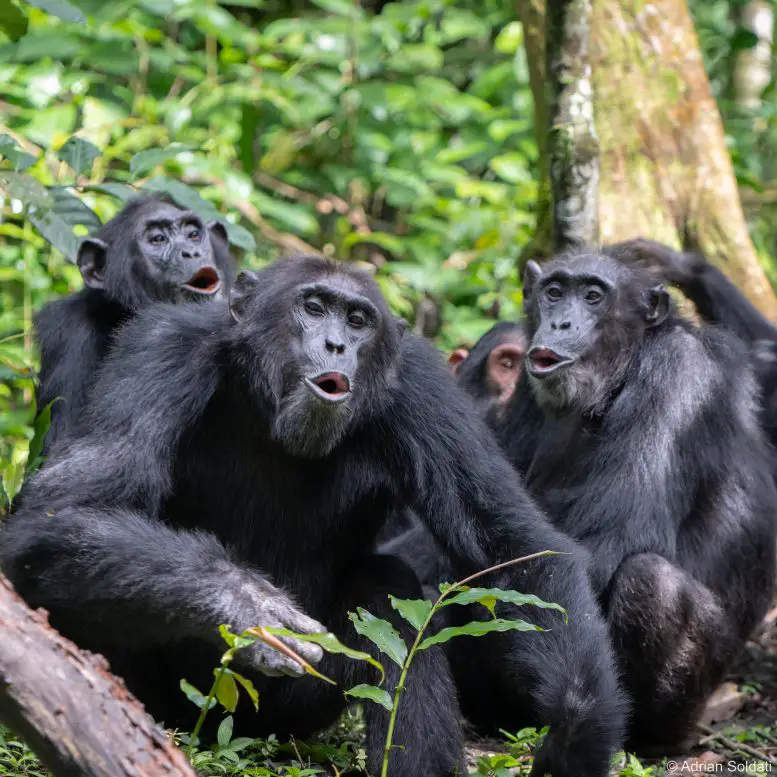The future of chimpanzee conservation depends on smart strategies that require detailed data that is not always easy to obtain. Ecologist Adrienne Chitayat led important research in Tanzania’s Mahale National Park, becoming the first person to systematically study chimpanzee population density in the park.
Chitayat’s doctoral thesis, conducted at the University of Amsterdam, looks set to lay an important foundation for the future conservation of this region, which is home to the largest chimpanzee population in Tanzania. This region is important not only for its biodiversity, but also for being the southernmost range of the eastern chimpanzee, an endangered subspecies.
Estimation of chimpanzee population density
Chimpanzees, like bonobos, are humans’ closest living relatives. Although the Greater Mahale ecosystem is large enough to cover approximately 20,000 square kilometers, research into chimpanzee populations in the park has been limited.
“There were estimates based on small or localized surveys, but there was no comprehensive baseline data. And without this data, it is difficult to understand chimpanzee population structure and develop good conservation strategies. My goal was to fill this gap,” Chitayat said.
Chimpanzees build new nests each night and rarely reuse them, making nest counts a reliable method of estimating population density. Chitayat conducted these counts throughout the park and determined chimpanzee density figures of between 1.1 and 3.7 per square kilometer, depending on the unique habitat characteristics of each area.
Ecosystems are threatened by climate change
The Mahale Mountains have a wide variety of landscapes, from dense forests to vast savannahs. Chitayat observed that chimpanzees occupied all of these habitats, even open vegetation, rather than sticking to forest areas. This discovery is very important because climate change threatens these ecosystems.
“When we look at how chimpanzees use the landscape and move through it, we can conclude that it is not just dense forests that are important for animal conservation,” Chitayat said. he said.
Protecting this broad range of habitats, including creating corridors, can support long-term population health and resilience.
Tracking chimpanzees using acoustic perception
Although traditional nest counting is effective, it is time consuming and expensive. Aware of the limitations, Chitayat developed a new monitoring approach: an acoustic detector based on deep learning. This technology uses passive acoustic monitoring to capture environmental sounds, including the screams of unusual chimpanzees that are difficult to observe up close.
“Passive acoustic monitoring is a revolutionary technique that automatically records all sounds near the acoustic device, including chimpanzee voices. With its help, you can find out where chimpanzees are, how often, when and how many.” said Chitayat.
“The problem is that you have hours, days, or even weeks of audio recordings that are too time consuming to listen to manually.”
Fortunately, the deep learning algorithm saves time and resources by automating the identification of chimpanzee sounds.
Understanding chimpanzee communication
Creating an acoustic detector presented unique challenges. Chimpanzees communicate using a complex range of sounds, from loud, distant “hums” to quieter grunts.
Chitayat focused his detector on screams that are vital to group cohesion and individual identity but difficult to interpret due to their variability. Developing a detector to recognize these calls required extensive training data and a complex algorithm; this was a significant advance in bioacoustics technology.
The future of chimpanzee conservation
Chitayat’s work opens important doors for future innovations. It involves the development of an acoustic detector to distinguish individual chimpanzees, providing insights into group demographics, social dynamics, and age and sex distribution.
Such data will be invaluable in shaping targeted conservation strategies for specific population needs. “The more we learn, the better we can protect chimpanzees,” Chitayat said.
This technology could improve not only our understanding of population size, but also the social structure and health of groups over time.
Increasing resilience with data-driven strategies
In his research, Chitayat aims to integrate ecological data into conservation plans for chimpanzees in the Greater Mahale ecosystem. By monitoring population density, movement patterns, and habitat use, conservationists can design interventions to meet the needs of this sensitive species.
In the age of climate change, this comprehensive data enables proactive measures to be taken, from protecting core habitats to creating corridors that allow chimpanzees to adapt to a changing environment.
Better understanding of chimpanzee populations
Chitayat’s contributions highlight the power of combining field ecology with advanced technology. Using nest counting, acoustic monitoring, and deep learning, their work provides a more comprehensive understanding of chimpanzee populations and provides a model for innovative conservation strategies. As climate change reshapes ecosystems, tools like Chitayat’s detector will be essential to adapt and respond to the challenges facing chimpanzee populations.
Source: Port Altele
